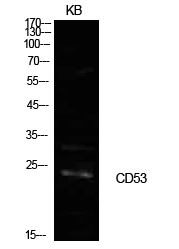CD53 Polyclonal Antibody
- Catalog No.:YT5591
- Applications:WB;ELISA
- Reactivity:Human;Mouse;Rat
- Target:
- CD53
- Gene Name:
- CD53
- Protein Name:
- Leukocyte surface antigen CD53
- Human Gene Id:
- 963
- Human Swiss Prot No:
- P19397
- Mouse Gene Id:
- 12508
- Mouse Swiss Prot No:
- Q61451
- Rat Gene Id:
- 24251
- Rat Swiss Prot No:
- P24485
- Immunogen:
- The antiserum was produced against synthesized peptide derived from the Internal region of human CD53. AA range:91-140
- Specificity:
- CD53 Polyclonal Antibody detects endogenous levels of CD53 protein.
- Formulation:
- Liquid in PBS containing 50% glycerol, 0.5% BSA and 0.02% sodium azide.
- Source:
- Polyclonal, Rabbit,IgG
- Dilution:
- WB 1:500 - 1:2000. ELISA: 1:10000. Not yet tested in other applications.
- Purification:
- The antibody was affinity-purified from rabbit antiserum by affinity-chromatography using epitope-specific immunogen.
- Concentration:
- 1 mg/ml
- Storage Stability:
- -15°C to -25°C/1 year(Do not lower than -25°C)
- Other Name:
- CD53;MOX44;TSPAN25;Leukocyte surface antigen CD53;Cell surface glycoprotein CD53;Tetraspanin-25;Tspan-25;CD53
- Observed Band(KD):
- 24kD
- Background:
- The protein encoded by this gene is a member of the transmembrane 4 superfamily, also known as the tetraspanin family. Most of these members are cell-surface proteins that are characterized by the presence of four hydrophobic domains. The proteins mediate signal transduction events that play a role in the regulation of cell development, activation, growth and motility. This encoded protein is a cell surface glycoprotein that is known to complex with integrins. It contributes to the transduction of CD2-generated signals in T cells and natural killer cells and has been suggested to play a role in growth regulation. Familial deficiency of this gene has been linked to an immunodeficiency associated with recurrent infectious diseases caused by bacteria, fungi and viruses. Alternative splicing results in multiple transcript variants. [provided by RefSeq, Mar 2016],
- Function:
- function:May be involved in growth regulation in hematopoietic cells.,similarity:Belongs to the tetraspanin (TM4SF) family.,tissue specificity:B-cells, monocytes, macrophages, neutrophils, single (CD4 or CD8) positive thymocytes and peripheral T-cells.,
- Subcellular Location:
- Cell membrane . Cell junction . Membrane; Multi-pass membrane protein. Concentrates in localized microdomains along the plasma membrane at the contact sites between cells of fused myotubes. .
- Expression:
- B-cells, monocytes, macrophages, neutrophils, single (CD4 or CD8) positive thymocytes and peripheral T-cells.
- June 19-2018
- WESTERN IMMUNOBLOTTING PROTOCOL
- June 19-2018
- IMMUNOHISTOCHEMISTRY-PARAFFIN PROTOCOL
- June 19-2018
- IMMUNOFLUORESCENCE PROTOCOL
- September 08-2020
- FLOW-CYTOMEYRT-PROTOCOL
- May 20-2022
- Cell-Based ELISA│解您多样本WB检测之困扰
- July 13-2018
- CELL-BASED-ELISA-PROTOCOL-FOR-ACETYL-PROTEIN
- July 13-2018
- CELL-BASED-ELISA-PROTOCOL-FOR-PHOSPHO-PROTEIN
- July 13-2018
- Antibody-FAQs
- Products Images

- Western Blot analysis of KB cells using CD53 Polyclonal Antibody. Secondary antibody(catalog#:RS0002) was diluted at 1:20000
.jpg)
- Western Blot analysis of KB cells using CD53 Polyclonal Antibody. Secondary antibody(catalog#:RS0002) was diluted at 1:20000



